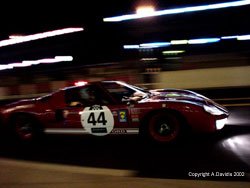 The inaugural Le Mans Classic is now over. From everyone you speak to the overwhelming feeling is that, despite the inevitable difficulties of running such a complex event, it was a great success, and everyone will be back for the next one.
The inaugural Le Mans Classic is now over. From everyone you speak to the overwhelming feeling is that, despite the inevitable difficulties of running such a complex event, it was a great success, and everyone will be back for the next one.
The principle behind the event was to re-enact the mighty battles of Le Mans past and the organisers went to great trouble to get as varied field as possible for each of the five ‘plateaus’, or grids. Comparisons with Goodwood are inevitable and one of the main differences was that competitors were charged an entry fee, rather than being ‘invited’ free of charge, with the proviso of sharing the car with a significant professional driver. This had the effect of gaining some cars whilst upsetting the owners of others, who were used to being treated differently at the English event. Whatever, most grids had just about all the cars you would expect to see and were many times over subscribed.
The 30,000 spectators who turned up were not disappointed with the quality of the spectacle if not the closeness of the actual racing, for those used to the main race at the 8.5 mile circuit will know that cars soon become strung out and the close dices we are used to at Goodwood are just not possible. The fact that the quality of the cars and the drivers varied so much did not help either. But for many (including your correspondent) just the sight and sound of fabulous machinery such as the Rahal/Redman Porsche 917 was worth the trip alone. Being situated at Tertre Rouge, courtesy of Nicholas Mee’s excellent hospitality set-up, I was able to see the cars commence the gentle climb up to the Mulsanne straight which, despite its two chicanes, is awesomely fast. David Franklin’s Lola T70 was believed to be reaching 210 mph along this section and the 917 in the dark was very quick indeed.
The fears expressed by many Le Mans veterans that the event would produce serious accidents was generally unfounded however the early hours of Sunday morning did see a very nasty crash involving several cars which led to the circuit being closed for two hours. As a result, the ensuing races were severely shortened in order to keep to the original format of five grids and four races per grid.
Where the event was so successfull was that by giving competitors a chance to drive over the full 24 hours an element of endurance, the key to success at Le Mans, was introduced, and speaking to a weary DB2 driver on the Sunday afternoon it was clear he felt he had genuinely had a taste of the real thing.
The future format of the event is unclear; it is believed to be next run in 2004 and possibly in July rather than September. There was considerable local business opposition to closing the public roads this year, which was only reconciled at a relatively late hour.
What is certain is that historic racing at the world’s most famous sports car circuit is very popular and the Le Mans Legend race (run in conjunction with the ACO and having no connection with this event) is definitely on next year as a support to the 24 Hours in June. This one will be a flat out blind for cars entered in the years 1959-1971.
For the top three results per grid please see our General Classification - Le Mans Classic 2002 table.
For more of Alexander Davidis' photos please see our exclusive Photo Gallery
Report by Steve Wakefield
Gallery Photos by:Olivier Penat/Steve Wakefield. All main shots by the kindest permission of Alexander Davidis and remain his strictly copyrighted material.
The Gallery;
 |
 |
 |
 |
 |
 |
 |
 |
 |
 |
 |
 |
 |
 |
 |
 |
 |
 |
 |
 |
 |
 |
 |
 |
 |
 |
 |
 |

